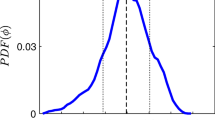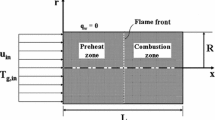Abstract
Direct numerical simulations of compressible two-dimensional homogeneous turbulent reacting flows are conducted to investigate the interactions between turbulence and chemical reaction. Both isothermal and exothermic nonpremixed reactions are considered. In isothermal reacting simulations, the turbulence is not affected by the reaction and is characterized by the large scale coherent vortices and vorticity-gradient sheet structures. The spatial structures of the density and temperature fields are similar to that of vorticity. However, mixing and reaction occur in the layer like (lamellar) structures which are mainly formed in the hyperbolic flow regions, where the vorticily-gradient sheets are present and the turbulent stretching dominates the circulation. Analysis of the simulations with exothermic reactions indicates that the heat of reaction has significant influence on thc spatial and the compositional structure of velocity, scalar and thermodynamic variables. The fluctuations of the density, the temperature, the pressure and the dilatation are substantially increased due to nonuniform heat release. The heat of reaction also modifies the small scale solenoidal velocity field. At early times, when the reaction is significant, the magnitude of the vorticity (enstrophy) is enhanced by the baroclinic vorticity generation. At late times, when the reaction is almost completed, the molecular dissipation is dominant and the magnitude of vorticity decays continuously. Examination of the energy transfer among the rotational and the compressive components of the kinetic energy and the internal energy indicates that the energy of reaction is transfered to the compressive component of the kinetic energy by the pressure-dilatation correlations. The turbulent advection then transfer the energy from the compressive component of the kinetic energy to its rotational component.
Similar content being viewed by others
REFERENCES
Babiano, A., Basdevant, C., Legras, B., and Sadourny, R. (1987). Vorticity and passive-scalar dynamics in two-dimensional turbulence, J. Fluid Mech. 183, 379–397.
Batchelor, G. K. (1969). Computation of the energy spectrum in homogeneous two-dimensional turbulence, Phys. Fluids 233–239 [suppl. II].
Baum, M., Poinsot, T. J., Haworth, D. C., and Darabiha, N. (1994). Direct numerical simulation of H2/O2/N2 flames with complex chemistry in two-dimensional turbulent flows, J. Fluid Mech. 281, 1–32.
Blaisdell, G. A., Mansour, N. N., and Reynolds, W. C. (1994). Compressibility effects on the passive scalar flux within homogeneous turbulence, Phys. Fluids 6, 3498–3500.
Brachet, M. E., Meneguzzi, M., Politano, H., and Sulem, P. L. (1988). The dynamics of freely decaying two-dimensional turbulence, J. Fluid Mech. 194, 333–349.
Chasnov, J. R. (1997). On the decay of two-dimensional homogeneous turbulence, Phys. Fluids 9, 171–180.
Chen, J. H., Mahalingam, S., Puri, I. K., and Vervisch, L., (eds.), (1992). Structure of Turbulent Non-premixed Flames Modeled with Two-step Chemistry, Proceedings of the 1992 Summer Program, Stanford University, Stanford, California. Center for Turbulence Research. Report CTR-S92.
Elhmaidi, D., Provenzale, A., and Babiano, A. (1993). Elementary topology of two-dimensional turbulence from lagrangian viewpoint and single-particle dispersion. J. Fluid Mech. 257, 533–558.
Erlebacher, G., Hussaini, M. Y., Kreiss, H. O., and Sarkar, S. (1990). The analysis and simulation of compressible turbulence, Theoret. Comput. Fluid Dynamics 2, 73–95.
Eswaran, V., and Pope, S. B. (1988). Direct numerical simulations of the turbulent mixing of a passive scalar, Phys. Fluids 31, 506–520.
Ghosh, S., and Matthaeus, W. H. (1992). Low Mach number Two-Dimensional hydrodynamic turbulence: Energy budget and density fluctuations in polytropic fluid. Phys. Fluids A 4, 148–164.
Givi, P. (1994). Spectral and random vortex methods in turbulent reacting flows. In Libby, P. A., and Williams F. A. (eds.), Turbulent Reacting Flows, Chap. 8. Academic Press, London, United Kingdom, pp. 475–572.
Herring, J. R., and McWilliams, J. C. (1985). Comparison of direct numerical simulation of two-dimensional turbulence with two-point closure: The effects of intermittency, J. Fluid Mech. 153, 229–242.
Herring, J. R., Orszag, S. A., Kraichnan, R. H., and Fox, D. G. (1974). Decay of two-dimensional homogeneous turbulence, J. Fluid Mech. 66, 417–444.
Jaberi, F. A., and Givi, P. (1995). Inter-layer diffusion model of scalar mixing in homogeneous turbulence, Combust. Sci. Tech. 104, 249.
Jaberi, F. A., and Madnia, C. K. (1998). Effects of heat of reaction on homogeneous compressible turbulence, J. Sci. Comput. 13.
Jaberi, F. A., Miller, R. S., Madnia, C. K., and Givi, P. (1996). Non-Gaussian scalar statistics in homogeneous turbulence, J. Fluid Mech. 313, 241–282.
Kerr, R. M. (1985). High-Order derivative correlations and the alignment of Small-Scale structures in isotropic numerical turbulence, J. Fluid Mech. 153, 31–58.
Kida, S., and Orszag, S. A. (1990). Energy and spectral dynamics in forced compressible turbulence, J. Sci. Comput. 5, 85–125.
Kida, S., and Orszag, S. A. (1991). Energy and spectral dynamics in decaying compressible turbulence, J. Sci. Comput. 7, 1–34.
Kraichnan, R. H. (1967). Intertial ranges in two-dimensional turbulence, Phys. Fluids 10, 1417–1423.
Ladeinde, F., O'Brien, E. E., Cai, X., and Liu, W. (1995). Advection by polytropic compressible turbulence, Phys. Fluids 7, 2848–2857.
Lesieur, M., and Herring, J. R. (1985). Diffusion of a passive scalar in two-dimensional turbulence, J. Fluid Mech. 161, 77–95.
McMurtry, P. A. (1987). Direct numerical simulation of a reacting mixing layer with chemical heat release. Ph.D. Thesis, Mechanical Engineering Department, University of Washington, Seattle, Washington.
McMurtry, P. A., Riley, J. J., and Metealfe, R. W. (1989). Effects of heat release on the large scale structures in a turbulent reacting mixing layer, J. Fluid Mech. 199, 297–332.
Miyauchi, T., Tanahashi, M., and Gao, F. (1994). Fractal characteristics of turbulent diffusion flames, Combust. Sci. Tech. 96, 135–154.
Passot, T., and Pouquet, A. (1987). Numerical simulation of compressible homogeneous flows in thee turbulent regime, J. Fluid Mech. 181, 441–466.
Porter, D. H., Pouquet, A., and Woodward, P. R. (1992). A numerical simulation of supersonic turbulence, Theoret. Comput. Fluid Dynamics 4, 13–49.
Santangelo, P., Benzi, R., and Legras, B. (1989). The generation of vortices in high-resolution, two-dimensional decaying turbulence and the influence of initial conditions on the breaking of self-similarity, Phys. Fluids 1, 1027–1034.
Warhaft, Z., and Lumley, J. L. (1978). An experimental study of the decay of temperature fluctuations in grid-generated turbulence, J. Fluid Mech. 88, 659.
Author information
Authors and Affiliations
Rights and permissions
About this article
Cite this article
Jaberi, F.A., James, S. Effects of Chemical Reaction on Two-Dimensional Turbulence. Journal of Scientific Computing 14, 31–72 (1999). https://doi.org/10.1023/A:1025672705324
Issue Date:
DOI: https://doi.org/10.1023/A:1025672705324




